In early April, 1982, Argentina invaded the Falkland Islands, a few desolate rocks in the South Atlantic. The British mobilized their fleet in response. On the 25th, a force retook South Georgia, a even smaller and more desolate island that Argentina had also captured, while the main task force closed in on the Falklands. May 1st saw the British launch their attack. The Argentine Navy tried to interfere the next day, but withdrew after the cruiser General Belgrano was sunk by a submarine. Two days later, the Argentines struck back, sinking the frigate Sheffield with an Exocet missile. Both sides settled in for a siege while the British waited for the amphibious force to arrive.1
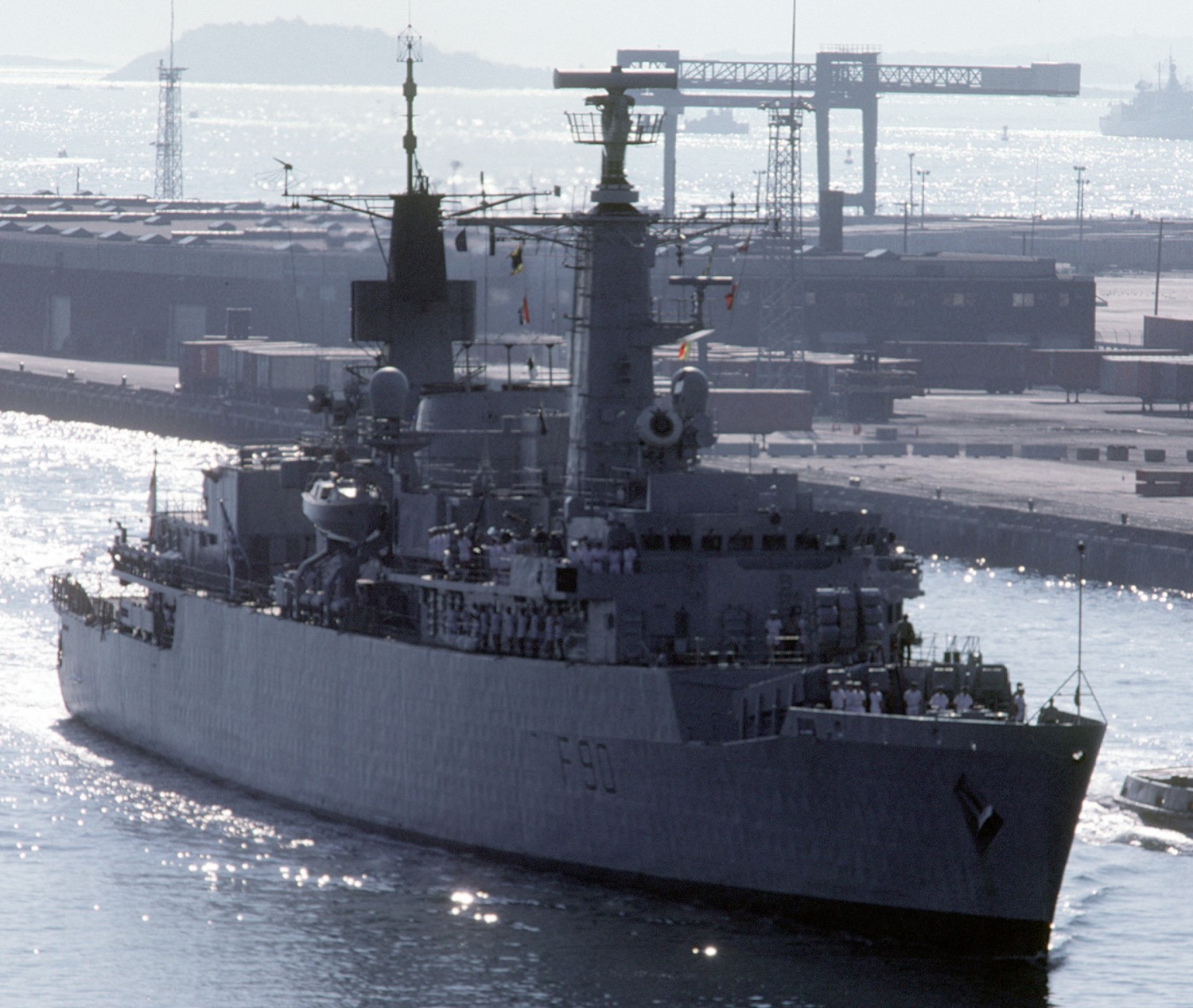
HMS Brilliant
On May 12th, the weather had improved, and Hermes was able to fly her first CAP mission since the 9th. The Harriers were fitted with 1000 lb bombs to be dropped from high altitude, the first level-bombing attacks from the Fleet Air Arm since 1940. These added to the ongoing bombardment from the fleet, supplied on the 12th by Brilliant and Glasgow. Shortly after noon, Brilliant detected an inbound raid, and the CAP was out of position to intercept. Fortunately, the group was about 15 miles out to sea, resting between bombardments and giving plenty of space for the missiles to engage. But when Glasgow's Sea Dart was ordered to fire on the attackers, it detected a problem and refused. The destroyer opened fire with her 4.5" gun, which jammed after 8 rounds. The Sea Wolf, though, functioned perfectly. Brilliant launched three missiles, two of which struck the incoming A-4 Skyhawks, blowing them apart. The third target dodged the missile by flying into the sea, and while it was too late to engage the last Skyhawk, its bomb skipped over Glasgow instead of hitting.
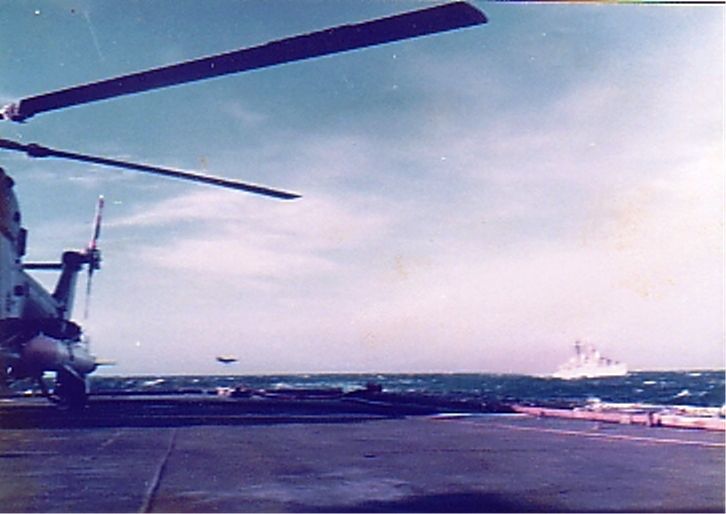
A-4 Skyhawks attacking Brilliant and Glasgow
Twenty minutes later, another raid appeared on the British radar screens, again out of range of the CAP. Glasgow’s crew was still trying to clear the problems with her weapons, but everyone was confident in Sea Wolf. The four Skyhawks adopted a different approach, weaving as they came in. When it came time to shoot, the Sea Wolf, designed as an anti-missile system and confused by the weaving, also failed, the launchers returning to the fore-and-aft position. This left only a few light guns on the two ships, which managed to hit at least one aircraft, but failed to do any substantial damage.2 One 1,000 lb bomb skipped over Brilliant, while another hit Glasgow amidships, passing through the vessel without exploding. It demolished the air intakes for the Tyne cruising turbines3 and damaged some other systems, as well as leaving a 3' hole in each side of the ship. 45 minutes after the second attack, the British picked up a third, but it merely circled and then turned for home. It took three days for the shipwrights to patch the holes, often laboring to weld patches while soaked by the incoming water. The Tynes were out of action for the rest of the war, and one of her Olympuses was also inoperative, while the other had been giving trouble, too. This left only Coventry to provide the fleet with area air defense, at least until Exeter, still two days north of Ascension, arrived. Admiral Woodward was forced to suspend the bombardment missions, and his force was further reduced when Arrow’s hull began to crack from the seas pounding the Task Force.
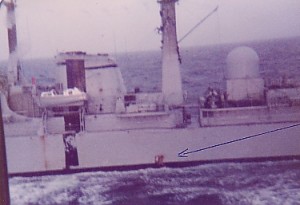
The hole in Glasgow's side
On the 13th, the weather closed in again, preventing flights from both the mainland bases and the ships of the Task Force. The 14th was clearer, but the main action came that evening when Hermes and a pair of escorts headed northeast and flew off a pair of Sea Kings loaded with members of the SAS. They were bound for the Argentine air base on Pebble Island, north of West Falkland. The Sea Kings dropped the party of 45 troopers and one naval gunfire observer three miles from the airfield, and the SAS men managed to penetrate the perimeter undetected, planting demolition charges on a number of the aircraft. They then opened fire on the rest with rockets and small arms, taking the defenders completely by surprise. Glamorgan, waiting offshore, joined in, blowing up the ammunition and fuel dumps. The defenders reacted by detonating the charges they had placed to make the airbase unusable if the British attempted to capture it, wounding one of the SAS troopers. Another was wounded in a brief firefight, but the entire team was successfully extracted by the helicopters shortly before daybreak. Overall, the Pebble Island raid was a complete success. Eleven aircraft4 were destroyed, and the airfield rendered unusable for the rest of the campaign.

A Pucara, one of the aircraft destroyed at Pebble Island
The next day, clouds over the Falklands prevented any reconnaissance, although the Harrier CAP did lob some bombs at the airfield. One exploded prematurely, and while this was originally chalked up to a fuze failure, it was later claimed that the bomb fell victim to a Roland SAM. The Argentine Navy came close to losing one of the long-range 707s when it overflew the Amphibious Group. One of the Sea Harriers loaded on Atlantic Conveyor had been kept operational for just such a contingency, but the weather was too bad for it to be safely launched. That evening, Alacrity repeated her transit through Falkland Sound, while Brilliant investigated a ship reported to be in Fox Bay on West Falkland. The defenders there were alert, and Brilliant's Lynx was driven off.
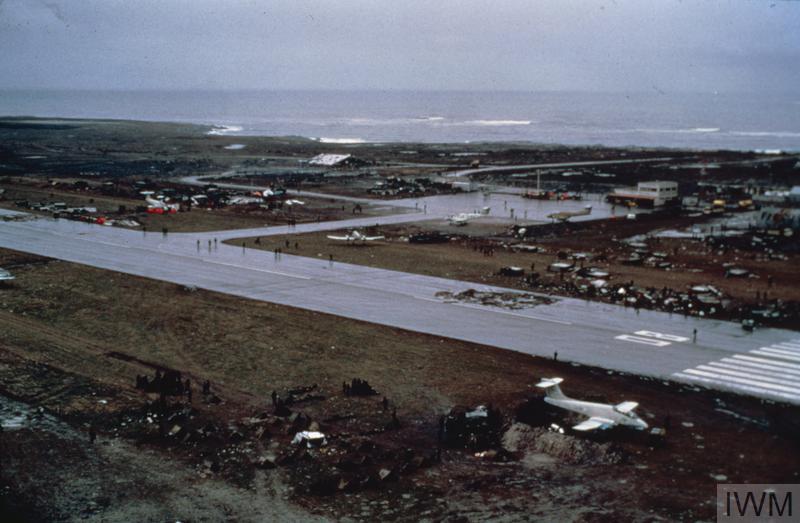
The runway at Stanley
Things remained quiet on the 16th, although the weather finally cleared enough for the British to hunt down several of the merchant ships that had been hiding around the islands. The freighter Rio Carcarana was located in Falkland Sound and bombed by a pair of Sea Harriers, while another pair of the jets located Bahia Buen Suceso in Fox Bay. She was too close to the settlement for bombs to be used, but they managed to damage her badly with 30mm fire, despite heavy AA from the defenders. A last photographic mission revealed another bomb crater in the runway at Stanley, although this was in fact a ruse by the defenders, who had gotten quite good at creating "craters" out of mud which could quickly be removed to allow the nightly supply aircraft to land, then rebuilt before it was light enough for the next recon run. The supply aircraft drill was down to a fine art. Air Force Hercules and Navy Electra transports would land, unload their cargo and pick up any wounded, transfer any excess fuel to the base, then fly off again, all without shutting down their engines.
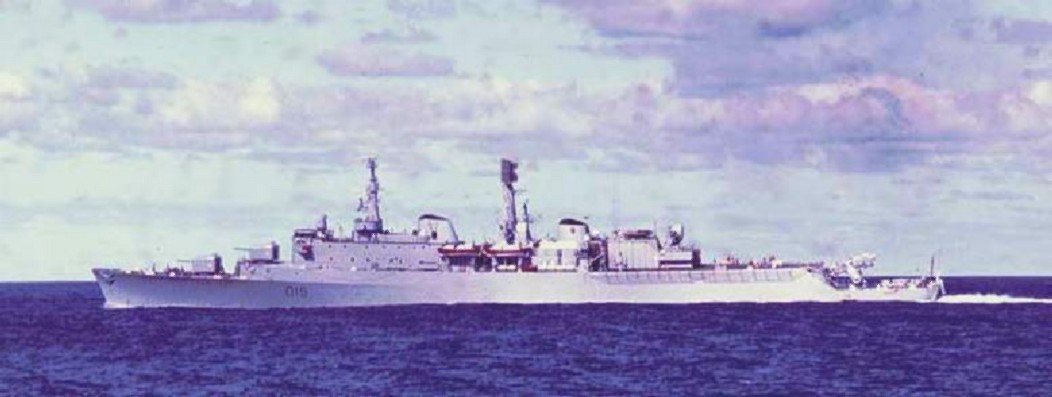
Glamorgan
The 16th was closed with a resumption of the naval bombardment runs when Admiral Woodward dispatched Glamorgan in to hit targets on East Falkand, including the Stanley area. She would be back many more times before the war was over. The day also saw all of the elements of the Amphibious Group finally meet up to begin the final approach to the island for the landing five days hence.
Argentina's Navy Day is May 17th, and the British, fearing another Exocet attack, reduced their offensive activity to a single recon run and a few bombs lobbed by the CAP. The Argentine Navy did not disappoint, although the last Neptune had given up the ghost on the 15th, and in the absence of a patrol aircraft, they had to rely entirely on information from VYCA-2, the air control group at Port Stanley, to figure out where the carriers were. The British were aware of this possibility, and Woodward's aviation staff had devised a deception plan to confuse VYCA-2. It was successful, and when the Super Etendards popped up to launch their attack, they found nothing but empty sea in front of them.
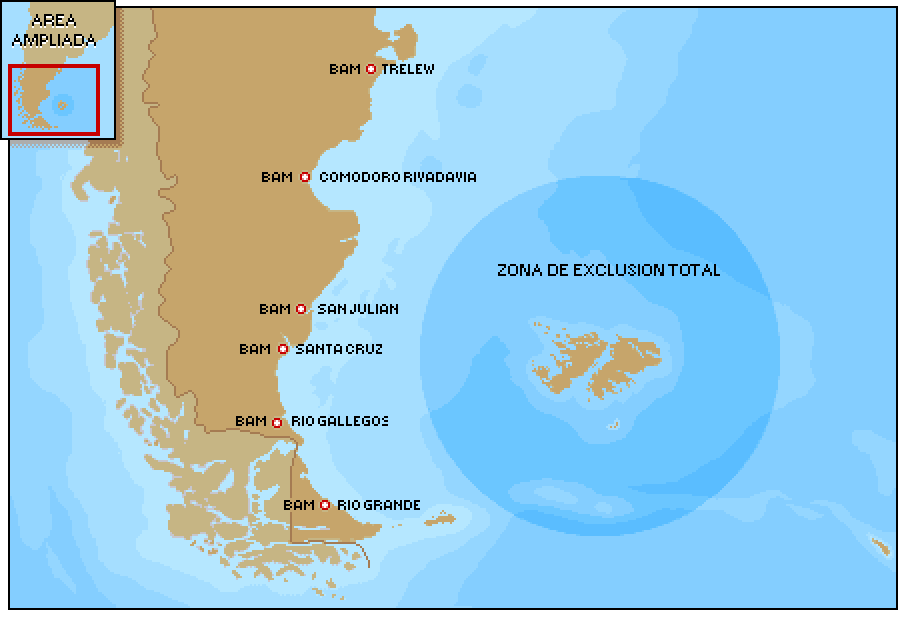
Argentine air bases, including Rio Grande
That afternoon, the carriers split up. Hermes steamed east, to rendezvous with Atlantic Conveyor and pick up the Harriers she had brought south. Invincible headed west at high speed, and flew off a single Sea King, then turned east again to be well out to sea by morning. The Sea King was carrying eight members of the SAS, tasked with reconnoitering the Argentine naval airbase at Rio Grande, Tierra Del Fuego, in preparation for a raid intended to destroy the Super Etendards. This plan would have seen a pair of C-130s land on the base's runway, and their passengers spread out to destroy the base. Afterwards, the C-130s would head for Chilean bases, where they would probably be interned for the duration of the war. As it was, things went wrong early on, when thick fog hindered navigation. The 8 SAS men were landed safely in Chile, but instead of being sunk in deep water as planned to hide its presence, the helicopter crashed on a Chilean beach, and the crew of three were picked up by the local authorities. The Argentine military had picked up the incoming helicopter on radar, and sent troops out to hunt down the SAS team. Eventually, the SAS troopers had to abandon their mission and sneak back into Chile. From there, they simply got on an airliner and flew back to Britain. With the main recon element gone, the plan had to be abandoned. In retrospect, this was probably a good thing. It was unlikely to work, and its failure could have been a major boost to Argentina and a severe blow to British morale.
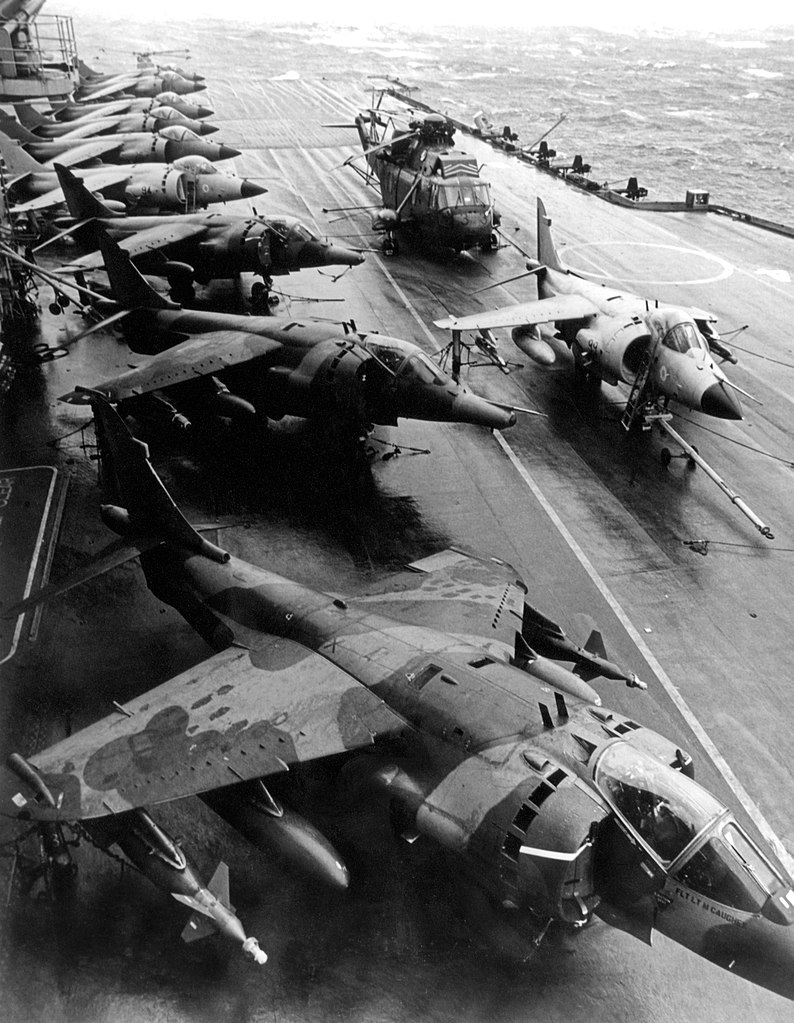
Harriers, Sea Harriers, and Sea Kings on the deck of Hermes
Most of May 18th was taken up with the transfer of the newly-arrived Sea Harriers and RAF Harriers from Atlantic Conveyor to Invincible and Hermes. The effort was entirely successful, despite the fact that many of the RAF pilots had no experience at all in flying from ships. That evening, the Carrier and Amphibious Groups rendezvoused, producing an unforgettable image of 32 ships steaming in company. Fortunately, the Argentine military missed the occasion, although the BBC informed them of it a few hours later. Needless to say, this did not make them popular with the men in the South Atlantic.
The 19th was mostly taken up with moving men and equipment around in preparation for the landings. The troops who had come south aboard Canberra had to be transferred to the vessels that could actually put them ashore, most notably Fearless and Intrepid. This was done by boat, which was particularly unpopular among the men of the Parachute Regiment. Tragedy struck that evening when a Sea King moving troopers of the SAS around hit a bird and crashed. 22 men were killed, including many survivors of one or both of the crashes on Fortuna Glacier. The carriers covered this operation, and flew familiarization flights for the RAF pilots who had just arrived.
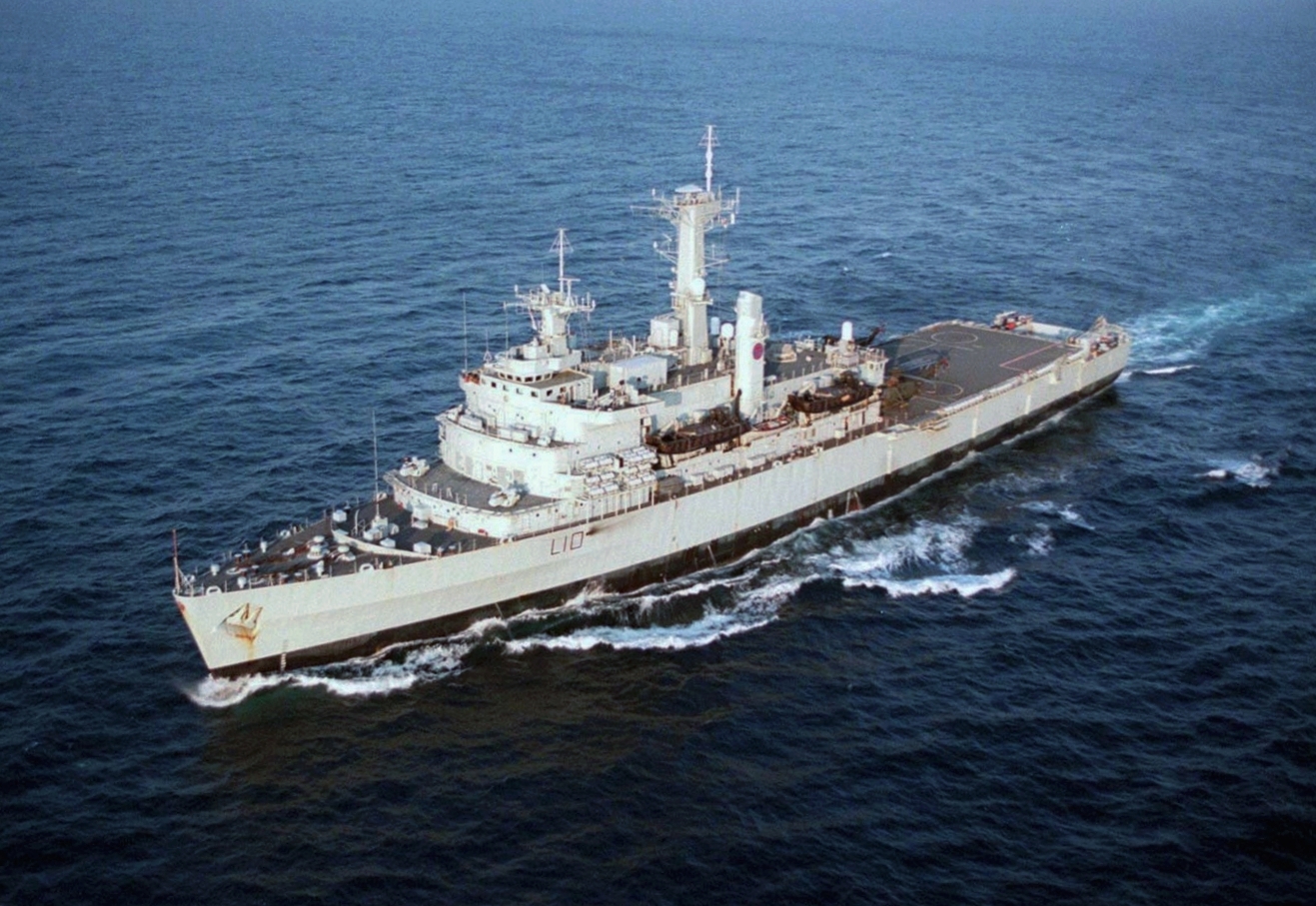
HMS Fearless
On the 20th, Admiral Woodward received formal word that the Cabinet had authorized the landings, and both groups entered the Total Exclusion Zone. They split up, the Amphibious Group heading for the beaches while the carriers continued the attack on Stanley. The day also marked the first offensive RAF sortie from a carrier since 1918, when three of the GR3s destroyed a large fuel dump at Fox Bay. That night, Glamorgan returned to the area around Stanley, doing her best to simulate a landing and draw Argentine eyes away from San Carlos Water, where the first troops were about to go ashore. We'll pick up the story there next time.
1 I've written a glossary to make it easier to keep track of terms in this series, and the full list of posts is here. ⇑
2 On their way out, the Skyhawks overflew Goose Green, and the Argentine air controllers failed to inform the defenders of their approach. The flight leader was shot down, killing the pilot. ⇑
3 The Type 42s had one Olympus and one Tyne gas turbine on each shaft. The Tyne was for cruising, while the Olympus was used for top speed. ⇑
4 Six Pucaras, four Turbo-Mentors and a Skyvan light transport. ⇑

Comments
I either had not heard of or had completely forgotten about Operation Mikado. It seems simultaneously audacious, foolish, and unnecessary.
One curious oversight, at least in the Wikipedia version, is the intended fate of the helicopter crew. Unless there was an unmentioned Royal Navy SSN in the vicinity, how did they expect to both sink the helo in deep water, and get the crew back?
I think that "deep water" means "deep enough to conceal the helo, and hopefully in a place where boats won't run into it". There are places like that close enough that someone in a life raft could row ashore. In fact, I believe they actually ditched the helicopter, but it wasn't sinking fast enough, and then it crashed when they brought it back to cut more holes in it. The recovery plan was to make contact with the British authorities in Puna Arenas, then presumably get the documents necessary to fly out.
The first level bombing from a carrier since 1940? That surprises me. They never again had cause to do it during WW2?
That's what my source says, and it's plausible. Level bombing is not very accurate unless you have a very sophisticated bombing system. In WWII, that requires a man to run it, so it's basically useless with anything that isn't an actual bomber, and even those have serious issues on targets smaller than a city. So you bomb in a dive, which lets the pilot see the target. The Harrier was probably the first airplane the FAA had that was capable of doing a decent job of level bombing.
Fearless was the Royal Navy's last non-nuclear steamship, serving until 2002. I remember seeing Fearless and Intrepid laid up in Fareham Creek awaiting disposal when I used to go sailing out of Portsmouth.
(AFAIK the RFA's last steam-powered auxiliary, the tanker RFA Olna, was decommissioned a couple of years earlier).
Reading this series I can see how destroying those Etendards would have been pretty tempting, but could landing transport planes on a hostile runway have possibly worked without gross incompetence by the base's defenders? Like either not seeing the plane coming until it's right on top of them, or holding fire in case it's an unscheduled friendly visit? Any sort of AA emplacement would have an unarmed closing target with limited ability to maneuver, and failing that, couldn't they just park a truck in the middle of the runway?
You're not wrong about just how insanely dangerous it would have been against a prepared opponent. But they know that, so doing so would take them totally by surprise.
Melchett-logic aside, it wasn't completely stupid. I doubt the British had particularly good intelligence on the nature of the base defenses, and the SAS team was inserted to gain that information. The information they gained was "not worth it", so it was cancelled. And it's just not the sort of thing you expect when you're several thousand miles from the closest enemy base. I don't think very many people expected it to work well, but it was worth the risk of at least looking into it more closely.
It worked perfectly well at Entebbe, six years earlier. More generally, attacks that couldn't possibly succeed against a competent defender, often succeed because nobody bothered to mount a defense of any kind. I know of at least one place where a similar attack could have succeeded against a critical US strategic asset, in the week following 9/11/01, and that's when the USAF knew not only that it was at war but at war with a power that was comfortable sneaking around US airspace in transport aircraft.
So the part of the plan where you send in an SAS team to check and see whether Rio Grande is actually defended, is probably worth doing if it doesn't cost too much. An SAS recon team interned and a helicopter lost, against the possibility of destroying Argentina's only proper maritime strike squadron.
Aha, that's the reframing I needed--from "Our plan is to land cargo plans at their airbase, phase I is SAS recon" to "Let's have SAS look at their airbase and see if they have anyone watching the skies".
From wikipedia, Operation Mikado apparently hoped to eliminate Argentina's three remaining Exocet missiles. You've commented before on the tendency of minor powers to skimp on things like ammunition for the shiny weapons and vehicles they like to show off, but that seems particularly egregious to me. Is that level of unpreparedness really the norm for minor powers? And are they all like that, or do some few do it less badly?
While that is a common problem, it wasn't actually why Argentina had so few missiles. They'd ordered more, but the French had embargoed them when war broke out.
The bomb didn't explode, and still managed to take out three of Glasgow's four turbines? I can't tell if that's amazingly good luck or amazingly bad luck.
It took out two turbines, not three. The Olympuses had been having mechanical problems unrelated to the bomb damage. And it took out the Tynes by damaging the shared air intake, AIUI. A less restricted design (the Type 42s were incredibly tight) would probably have duplicated those, significantly improving survivability.
A surprising amount of this story is about how major weapon systems and vessels, on both sides, just had breakdowns unrelated to combat damage.
Is it just that the South Atlantic is that nasty, that both sides were trying to use equipment at the edge of the operational envelope, or that this happens all the time with military stuff and normally we don't hear about it?
Yes to all of the above. The South Atlantic is nasty, and that puts added strain on systems. Things like missile launchers and guns don't like being battered by storms.
The Sea Wolf thing is clearly out of envelope problems, for instance, and I suspect that lots of ships sailed with problems aboard that would not have been acceptable in peacetime. Glasgow came straight from an exercise in the Med, and there isn't a lot you can do to repair gas turbines while underway. The procedure is to remove them and replace. Easy enough in dockyard hands, hard to do on the open sea, although Invincible did manage it.
But complex military equipment is hard to build and hard to test. At one point, the US commissioned a ship that used different word lengths for two computer systems, and as a result, she wasn't actually operational for a couple years after commissioning. I've shared a story about a somewhat less glaring fault like that, but this kind of stuff is really hard to test for. (I should know. It's my day job.) In fact, I suspect this is an area we'll have a substantial advantage over the Russians/Chinese/Norks. There are several Russian systems that I know of which have severe operational limitations, usually ones that would make them essentially impotent in a war. And one of the reasons for the stretch in weapons development is that these days, we take the time to make something an actual weapon before putting it into service instead of waiting until it's "operational" to do so. I strongly suspect the Russians often skip that step entirely.